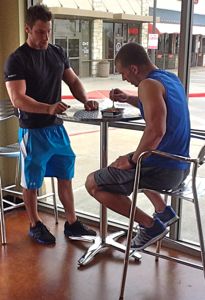 Eating is a fundamental part of life. You do it every day – several times each day. We strive to treat our bodies well – after all, it’s the only one we have, and it’s a gift from God. We all eat, but our motives and the end results can be very different. Food is fuel, and with proper fuel, you can achieve your fitness goals, whatever they may be.
Eating is a fundamental part of life. You do it every day – several times each day. We strive to treat our bodies well – after all, it’s the only one we have, and it’s a gift from God. We all eat, but our motives and the end results can be very different. Food is fuel, and with proper fuel, you can achieve your fitness goals, whatever they may be.
Some people, believe it or not, are actually trying to gain weight – to have the strength to do a certain job, to better perform a physical activity or to have a well-developed muscular form. Those goals require a diet constructed with lean muscle mass gains in mind.
For other people, losing body fat and improving fitness and energy is the goal.
Registered Dietitian and Certified Personal Trainer Tim McComsey breaks down the science of eating to gain or lose, examines key factors necessary to achieve these different but important goals and identifies the foods that will help you get there. Tim will help you to put the right fuel in your body to reach YOUR personal goal.
 GAINING WEIGHT THE RIGHT WAY
GAINING WEIGHT THE RIGHT WAY
Eating to gain weight is not as easy as it sounds – you can’t gain the right type of weight by just sitting around downing burritos and ice cream. Gaining healthy weight involves adding muscle mass and minimizing your fat gain. Building muscle requires a positive energy balance — you have to take in more calories than you burn. Here are five important things to keep in mind if you’re trying to gain muscle weight:
Healthy weight gain pillar number one: Adjust your calorie intake. Figure out how many extra calories you should eat to gain muscle mass. This number depends on how many calories you burn each day. There are plenty of formulas that you can use to calculate your caloric intake, which are based on your age, height, sex, weight, and activity level. One of my favorite sites is a Body Mass Index (BMI) calculator. Once you figure out how many calories you burn each day, add between 250-500 calories per day.
Each person’s body processes additional calories differently — if you know you gain weight easily, you should stay on the low end of the range. If you have a hard time gaining weight, aim for the higher end of the range. It will take some time to figure out what works for you – don’t get frustrated! Just be patient and adjust accordingly – remember the key is to build muscle while staying as lean as possible.
Healthy weight gain pillar number two: Eat more protein. Learn the difference between complete and incomplete proteins. In order to build muscle, you need complete proteins, which are found in eggs, meat, fish, cheese, milk and most other animal products. The protein found in plant products tends to be incomplete, though there are important exceptions, including soy beans and quinoa. Every time you eat, you should consume complete proteins or a combination of incomplete proteins, such as brown rice and beans.
In dietetics, we use a measure called the protein digestibility corrected amnio acid score (PDCAAS) to judge “good” proteins. It’s a mouthful, but PDCAAS is basically a measure of how easily different proteins are digested by the body. Think of PDCAAS as grading the quality of protein with 1 being the highest score and 0 the lowest. For example, whey, casein, and milk all score 1 on PDCAAS whereas whole wheat scores a 0.42. So when trying to optimize each calorie you put in your body you want to focus on the foods with a high PDCAAS. Again, we see some of the same “good weight gain” foods reappear when considering PDCAAS: milk proteins (whey and casein), beef, egg whites, soybeans, and legumes, just to name a few.
 Once you choose your favorite good proteins, you need to eat a sufficient amount of protein on a daily basis. An easy rule of thumb is that you need between 1 and 1.5 times your body weight (if you are overweight, then substitute your target body weight) in grams of protein. For example, if you weigh 180 pounds, you should eat between 180 and 270 grams of protein per day to consistently gain muscle.
Once you choose your favorite good proteins, you need to eat a sufficient amount of protein on a daily basis. An easy rule of thumb is that you need between 1 and 1.5 times your body weight (if you are overweight, then substitute your target body weight) in grams of protein. For example, if you weigh 180 pounds, you should eat between 180 and 270 grams of protein per day to consistently gain muscle.
Full-time bodybuilders can sometimes eat two to three times their body weight in grams of protein, but for most of us that would be overkill. A serving of protein is about the size of the palm of your hand. Men should get two portions per meal and women one portion (20-30 grams). Research suggests that consuming lean protein 15 to 20 minutes before, during and within one hour of working out may help improve muscle gain. Since you are probably not going to be eating a steak or chicken breast at the gym, a protein drink or supplement may be beneficial immediately before, during or after workouts. Once you calculate your total protein intake each day, divide it into 5-6 smaller meals for easier consumption.
Healthy weight gain pillar number three: Round it out with carbs. In addition to protein, your body needs a good daily dose of carbs to gain muscle. Loading up on carbohydrates allows your body to tap into glycogen (energy) stores within your muscles while you are working out. If you do not eat enough carbohydrates your body will not have energy reserves and will break down your muscles instead!
The ideal type of carbs are low-glycemic carbohydrates, which do not raise the level of glucose (sugar) in your blood — preventing your body from having to release large amounts of insulin into the blood stream and ultimately from storing any extra glucose as fat. The low-glycemic carbohydrates are a sustained energy source that burn slowly as you work out.
When trying to gain muscle mass, you should consume fruits and vegetables each time you eat, eat whole grain and starchy (low-glycemic) carbohydrates within three hours of working out, and if you must consume simple sugars and highly processed (hi-glycemic) starches, eat those immediately after working out. A person looking to gain muscle mass should consider supplements before, during, and after their workouts with a liquid protein/simple sugar (hi-glycemic) shake that will provide the essential nutrients needed for energy and well tolerated over whole food.
Healthy weight gain pillar number four: Eat your veggies. To ensure optimal physiological functioning it is imperative to eat up to 10 servings of vegetables a day — they contain vitamins, minerals, and phytochemicals. Vegetables also provide an alkaline load to the blood — they generate a slightly higher pH value in the body, and offset the acid loads delivered by proteins and grains. Keeping your blood balanced prevents the loss of bone strength and muscle mass, which would detract from any healthy weight you’ve gained.
Healthy weight gain pillar number five: Eat often. As you can imagine, eating enough protein and carbs to gain healthy weight would be very difficult on a typical North American diet of three meals per day. You should strive to eat every two to four waking hours from the moment you wake up to the time you go to bed — that could add up to as many as four to seven meals per day. This regular feeding stimulates your metabolism and balances your blood sugar throughout the day.
The important part to remember is to always make sure your calories are above and beyond what you burn on a daily basis. It is impossible for your body to digest all the protein and calories you need in one sitting. Spreading your calorie intake over the course of the day will ensure that your body absorbs the quality nutrients you need and also allows you to avoid the calorie-dense foods that are more likely to promote fat storage.
In review. Let’s recap: to gain healthy weight, you want to eat 4-7 meals a day that each include lean, complete protein, carbohydrates, and green vegetables. When following this plan, CONSISTENCY is key. You have to eat well, day in and day out, along with your well-planned workouts to gain healthy weight and muscle mass.
 LOSING WEIGHT THE SAFE WAY
LOSING WEIGHT THE SAFE WAY
When most people think about losing weight, they picture eating miniscule amounts of food, going on “crash diets,” or working out for hours every day. Not only are those plans unhealthy, any early weight loss won’t last. The good news is that there are healthy, worthwhile ways to lose weight – and the weight will stay off. The principles behind healthy weight loss are similar to those for weight gain, with a few important changes.
Healthy weight loss pillar number one: Eat fewer calories. Obvious, right? The important part is to not stop eating altogether. Similar to the calculations we did above for gaining muscle mass, people who want to lose weight need to adjust their calories in proportion to their daily intake – but of course, subtracting calories instead of adding them.
There is no magic number, but you should aim to subtract between 250 and 500 calories, depending on your body’s natural ability to lose weight. Again – it is trial and error. Try starting off on the lower end of the range and see how your body responds. The key is to maximize fat-burning while minimizing catabolism (breakdown) of your muscle mass.
Healthy weight loss pillar number two: Don’t stop eating. Even if you’re trying to lose weight, you need to eat every two to four waking hours. At the end of the day, you still may have to eat up to seven times to get the nutrients your body needs.
To lose weight, you need to eat balanced meals, including complete, lean protein with each meal. Eating protein every time you eat will stimulate your metabolism (burn more calories), improve your muscle mass and recovery, and reduce your body fat because your body burns more calories digesting protein than other types of food.
Healthy weight loss pillar number three: Take it easy on the carbs. When trying to lose weight, you should minimize intake of highly-processed simple sugars and hi-glycemic carbohydrates except during exercise. You should strive to eat carbohydrates only when you earn them — if you exercise, you can eat whole grain, unprocessed carbohydrates within three hours of your workout. If you don’t work out, then there are no starchy carbohydrates for you — only fruits and vegetables.
It is important to remember that you are controlling your carbohydrate intake not eliminating them.
Healthy weight loss pillar number four: Keep the green stuff coming. To burn fat, you must consume vegetables every time you eat. Vegetables destroy free radicals, fight cancer, neutralize acid and provide micronutrients that your body needs to survive.
For a closer look at the chemical processes that go on in your body and the vitamins and nutrients that fuel it read Dr. Deborah White’s article Feed Your Chemical Body. To gain a better understanding of the role vegetables can play in your life read Taste The Rainbow.
Healthy weight loss pillar number five: Know your fats. The last thing you need when trying to burn fat is to eat fat. Only about 30% of your diet should come from fat. You need a balance of saturated fat, polyunsaturated fat, and monounsaturated fat — around 10% of each — to optimize your health, body composition, and performance.
To gain a better understanding of why in fact saturated fat is a part of a healthy diet read Why God Made Saturated Fat.
LET’S TALK ABOUT FOOD
Now that you know the basic pillars for gaining or losing weight, let’s consider some good foods to choose for either diet.
 MY DIET, MY JOURNEY AND MY FAITH
MY DIET, MY JOURNEY AND MY FAITH
My journey to get to where I am today — a happy and healthy entrepreneur — began in 2005 when I was 22 years old. I competed in my first Natural Bodybuilding Competition, weighing 155 pounds, and immediately fell in love with the discipline that comes with training, eating and preparing for a competition. I did two competitions that year as a lightweight bodybuilder.
The following year (2006) I suffered a very bad lower body injury that prevented me from any kind of training for months. I remember waking up every morning and being in so much pain it was almost impossible to get myself out of bed — an experience I would never wish upon anyone. However, I was determined to make it to a competition exactly one year from the date that I was injured. I began lifting weights again with my upper body and slowly did my own rehab for my legs. After six months the pain decreased significantly and my range of motion in my leg was increasing. It was a tough setback to overcome but I believe my family, friends, and my faith were a driving force in helping me achieve my goal.
 My friends who were my co-workers at my gym in Pennsylvania couldn’t have been more supportive and motivating to help me push myself to my limits. I truly believe it was my faith in God that propelled me, allowing me to overcome any pain that I was enduring. During the whole recovery and therapy process I gave thanks to God everyday that things were not worse and that I still had two legs to walk on. As my legs became stronger and more mobile my faith grew stronger. I did achieve my goal of competing in the competition exactly one year after I got hurt. After I achieved that goal, my career with bodybuilding ended and I was drawn in the direction of fitness modeling.
My friends who were my co-workers at my gym in Pennsylvania couldn’t have been more supportive and motivating to help me push myself to my limits. I truly believe it was my faith in God that propelled me, allowing me to overcome any pain that I was enduring. During the whole recovery and therapy process I gave thanks to God everyday that things were not worse and that I still had two legs to walk on. As my legs became stronger and more mobile my faith grew stronger. I did achieve my goal of competing in the competition exactly one year after I got hurt. After I achieved that goal, my career with bodybuilding ended and I was drawn in the direction of fitness modeling.
I believe God knew what was intended for me and showed me what I needed to do get where I am today. Praying often for the well-being of everyone I knew and being thankful for the life I was given really helped me form a relationship with God. He has shown me through my pain that I am meant to help others live a healthier lifestyle. I wouldn’t have been so passionate about my drive to help others if I never experienced life though pain. I strive to live a healthy life, which includes my faith, eating well, working out, and being social.
My faith plays a huge role in how I perform my daily activities, whether running my personal training business, TRyM Fitness, working out, deciding what to eat and spending time with others. I am thankful for my life and my overall health.
Now that you have a better idea of how to eat to gain or lose weight, I want you to keep one important concept in mind. I sincerely believe God has given us each one body and one life. Why not treat it the best you can? I chose to live a healthy lifestyle and share my experiences with my clients, peers, and anyone who wants a healthy mind and body.







